Wolfram Data Drop uses IoT data to answer any question
Wolfram has created an easy way to collect, store and analyse Internet of Things data


The Internet of Things (IoT) will create oodles of data – but where should we put it before we analyse it?
Wolfram thinks it has an answer, with its new Data Drop, a product that collects data from connected devices and other sources in order to be read and used.
"At a functional level, it’s a universal accumulator of data, set up to get — and organise — data coming from sensors, devices, programs, or for that matter, humans or anything else,” founder Stephen Wolfram explained in a blog post. “And to store this data in the cloud in a way that makes it completely seamless to compute with.”
Data can be gathered from web APIs, sent via email or web forms, from connected devices, and from the Raspberry Pi. There's also experimental support via Twitter – simply tweet at @WolframDataDrop to add data – and the company is working on supporting data drops via a mobile app, embedded code and Arduino sensors.
"Our goal is to make it incredibly straightforward to get data into the Wolfram Data Drop from anywhere," he said. "But wherever the data comes from, the idea is that the Wolfram Data Drop stores it in a standardised way, in a 'databin', with a definite ID."
Once that data is stored in a Wolfram “databin”, you can use the Wolfram Data Framework and Wolfram Language to analyse it.
One example the founder used was being able to track the weather at his own desk. That data is automatically sent to Wolfram Data Drop, where it can be played with: he can convert it to Fahrenheit, plot it over time, and, because the company's own “Knowledgebase” has historical weather data, he can compare it to previous conditions.
Get the ITPro daily newsletter
Sign up today and you will receive a free copy of our Future Focus 2025 report - the leading guidance on AI, cybersecurity and other IT challenges as per 700+ senior executives
“If we wanted, we could do all sorts of fancy time series analysis, machine learning, modeling, or whatever, with the data,” he said. “Or we could do elaborate visualisations of it. Or we could set up structured or natural language queries on it.”
The key to all of this is that the IoT data stored by Wolfram isn't simply raw data, it “has real meaning attached to it”.
That's because it all has units attached – for example, it's not just a number, it's a temperature, – “so it can be unambiguously understood wherever it’s going to be used”.
Wolfram said setting up a databin is so easy that they're now being widely used across the company – including to take snapshots of the office fish, which can be used to make a heatmap of where they spend their time in the aquarium, and to manage the server room's temperature and weather sensors on the building's roof.
The service is free for anyone dealing with “fairly modest amounts of data”, and there will be a scaled charge for more demanding use cases. The beta launched today, and is available here.
Freelance journalist Nicole Kobie first started writing for ITPro in 2007, with bylines in New Scientist, Wired, PC Pro and many more.
Nicole the author of a book about the history of technology, The Long History of the Future.
-
 Asus ZenScreen Fold OLED MQ17QH review
Asus ZenScreen Fold OLED MQ17QH reviewReviews A stunning foldable 17.3in OLED display – but it's too expensive to be anything more than a thrilling tech demo
By Sasha Muller
-
 How the UK MoJ achieved secure networks for prisons and offices with Palo Alto Networks
How the UK MoJ achieved secure networks for prisons and offices with Palo Alto NetworksCase study Adopting zero trust is a necessity when your own users are trying to launch cyber attacks
By Rory Bathgate